The Changing Face of Our Oceans Part 5: Invaders
Part 1, Part 2, Part 3, Part 4
There's a brutal, violent invasion going on in the Caribbean Sea right now. It's not often showing up on the news, however. This is most likely because the invasion is occuring entirely underwater. The identity of the invader? The gorgeous lionfish, a species native to the Indian Ocean.
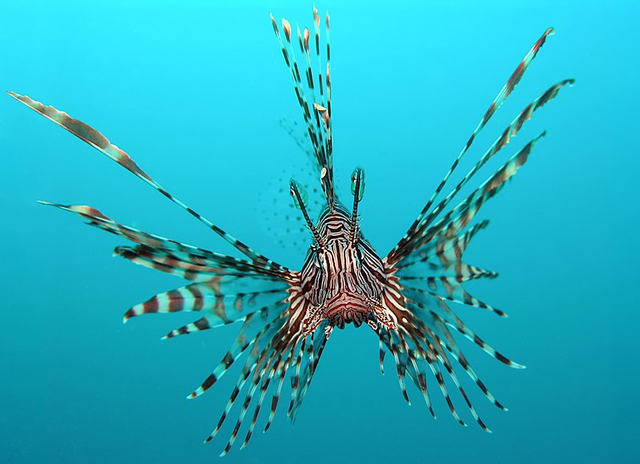
Pterois volitans, one of the two species of lionfish that have established themselves in the Caribbean. They comprise around 93% of the Caribbean lionfish population. [Image source]
The lionfish isn't just called the lionfish for its "mane" of 18 venomous spines. (The venom is strong enough to kill a small child or extremely sicken an adult human.) The lionfish hunts in packs, and coordinates elaborate hunting strategies, with lionfish herding prey into each others mouths. They blow jets of water at prey to disorient them- and since small fish tend to swim against the current while escaping, they often swim straight towards the lionfish's mouth. They're suction feeders- they inhale entire prey into their mouths whole. Because of this, they tend to target the young of other fish species. As if all of this wasn't bad enough, they reproduce monthly during their 5-15 year lifespan, with each female releasing up to 15,000 eggs per month.
Lionfish were introduced to the Caribbean thanks to the aquarium trade. Lionfish are difficult fish to keep, but are often marketed to amateurs, one or more of whom likely released their lionfish into the ocean when they weren't able to care for them. (There is an alternate theory claiming that six lionfish were washed out to sea from a destroyed aquarium during 1992's Hurricane Andrew. Regardless, the lionfish definitely were introduced from Florida.)
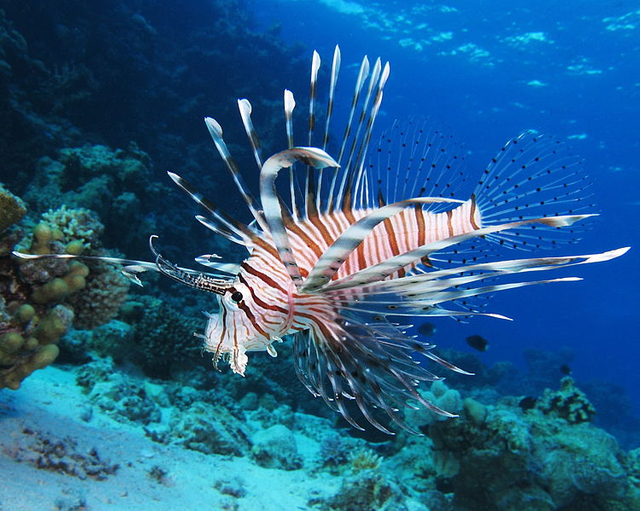
Pterois miles, the other lionfish species that has invaded the Caribbean. [Image source]
While the lionfish populations haven't yet grown to an overwhelming problem, they're not far off- they're thought to be pushing down diversity on coral reefs they're found on by as much as 80%. The lionfish lack almost any natural predators in the Caribbean. Groupers eat them, but unfortunately we eat groupers, and have badly overfished their population. There is, thankfully, at least one predator we can count on to hunt lionfish- ourselves. They're quite tasty, and by the simple expedient of cutting off their spines with scissors they're made safe to eat. (Their venom is broken down by heat, so cooking them denatures any that might be left.)
Us eating them might not be enough on its own, though- even if we start eating large amounts of them, we have to hunt them via spearfishing so as not to damage the reefs, which does limit our catch in some ways. Lionfish have also been shown to be much more cautious when they're frequently spear hunted on a particular reef. In addition, lionfish populations have been found quite deep- past 200 m in depth, in fact, well beyond easy dive range. Still, though, promoting lionfish consumption's not a bad plan by any means. If you're really interested in helping fight lionfish, start trying to find restaurants or grocery stores that carry it. None in your local area that do? Request that they start carrying it.
Lionfish are hardly the only invasive species in the ocean, however. I've talked about invasive species before, and I'll certainly talk about them again- they're by far one of the most environmentally destructive side-effects of human civilization, in the ocean as much as anywhere else. There are quite a few different causes other than the aquarium trade, as well.
One major cause of invasive oceanic species is canals. The bigger canals allow easy access between major bodies of water. The Suez and Panama Canals are notable offenders here. The migration of species from the Red Sea to the Mediterranean via the Suez Canal has grown to be such a huge problem that it's gained its own name, the Lessepsian migration, named after the diplomat in charge of the canal's construction.
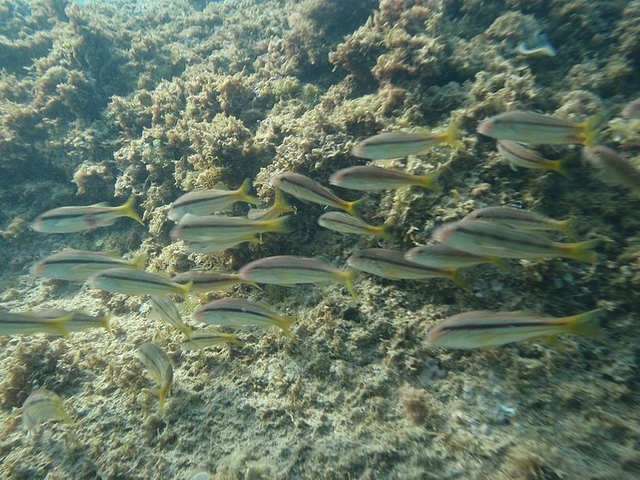
The goldband goatfish, a Lessepsian migrant. The goatfish has almost entirely displaced the native red mullet into deeper waters- the goatfish now makes up 87% of the catch for fishermen that would formerly have been red mullet. [Image source]
For the most part, the Lessepsian migration overwhelmingly happens from the Red Sea to the Mediterranean. There's a few reasons for this. The Red Sea is higher in elevation than the Mediterranean, meaning there is a current flowing towards the latter. The Red Sea is also saltier and less nutrient rich than the Mediterranean, meaning that species from the latter have a tougher time surviving in the former than vice versa. The Lessepsian migration didn't start immediately after construction of the Suez Canal, interestingly- there were two immensely salty lakes known as the Bitter Lakes the canal passed through that prevented sea life from passing. Eventually, however, the salinity across the canal evened out, allowing invasions.
Terrifyingly, both the Panama Canal and the Suez Canal are likely to be expanded soon, allowing even more invasive species to pass.
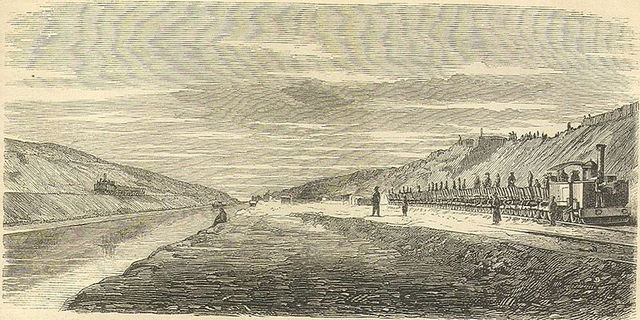
The construction of the Suez Canal. Engraving from 1869. [Image source]
There's another, even bigger source of aquatic invasive species however- ships. Ships carry invasive species in one of two ways, generally. First off is just hitching a ride on the hull. Barnacles, seaweeds, and similar sessiles tend to do this pretty often. This can be alleviated by cleaning off the hull regularly. This is a great idea anyways, since organisms latching onto the hull create drag and slow the ship down. There are also paints and such that prevent organisms from latching on.
Something that carries even more invasive species aboard ships than the hull, however, is ballast tanks. Ballast tanks, located in the depths of the ship are filled with water to provide the ship with enough weight that it's less affected by waves and wind. The water is generally just pumped from immediately outside the ship. Unfortunately, there isn't a way to keep small organisms from being pumped in- fish, snails, etc. When the water is pumped out as cargo is loaded in at a port, the species can take root at the new location. This is actually the primary method of oceanic invasive species spread on the planet.
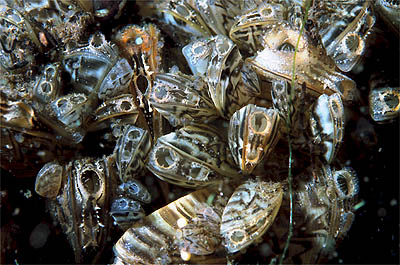
Zebra mussels underwater. [Image source]
One of the worst invasive species spread this way is the zebra mussel, an immensely destructive species. The ballast tanks tend to pick up their microscopic larva, so inspecting ship hulls for zebra mussels only stop a few of them. They disrupt ecosystems, clog water treatment plants, block cooling intakes for power plants, block dam water intakes, and more. They breed at absurd speeds and aren't eaten by much. They've been spread all over the world by ballast tanks on cargo ships. The ridiculous thing about it? It's a freshwater species being spread by seagoing ships. They're taking on ballast in freshwater and dumping it back into freshwater somewhere else. Fixes like dumping freshwater ballast in saltwater and saltwater ballast in freshwater are one solution to the problem, but not all ships travel in both fresh and saltwater, so more solutions are needed. Treating the ballast water with chemicals to kill creatures living in it is another potential solution.
The final major type of aquatic invasive species spread method is via ecosystem disruption. When we wreck an aquatic ecosystem, it leaves vulnerabilities for species from neighboring ecosystems to invade- and invade they do. Of course, we can't forget the biggest invasive species of all- us. We might not live in the ocean, but we have an environmental footprint functionally indistinguishable from a species that lives in the ocean, as far as the ocean's concerned.
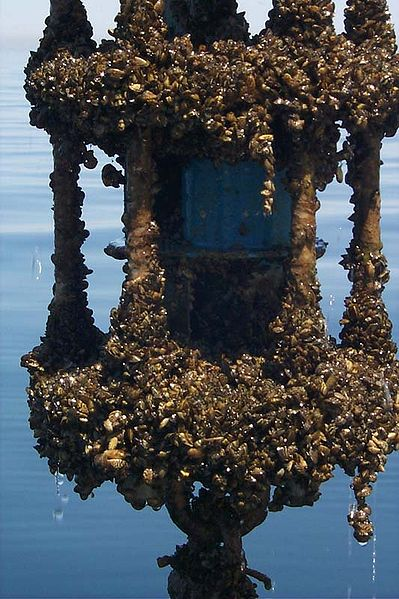
A zebra mussel infestation. [Image source]
Bibliography:
- The Ocean of Life: The Fate of Man and the Sea, by Callum Roberts
- The Sixth Extinction, by Elizabeth Kolbert
- http://www.wri.org/atlantic-and-caribbean-lionfish-invasion-threatens-reefs
- https://en.wikipedia.org/wiki/Pterois
- https://news.nationalgeographic.com/news/2015/02/150223-panama-canal-expansion-invasive-species-environment/
- https://en.wikipedia.org/wiki/Lessepsian_migration
- https://en.wikipedia.org/wiki/Sailing_ballast
- https://en.wikipedia.org/wiki/Ballast_water_discharge_and_the_environment
- https://en.wikipedia.org/wiki/Zebra_mussel#As_an_invasive_species

Being A SteemStem Member
You received a 80.0% upvote since you are a member of geopolis and wrote in the category of "ecology".
To read more about us and what we do, click here.
https://steemit.com/geopolis/@geopolis/geopolis-the-community-for-global-sciences-update-4
I've been meaning to get around to commenting on this. As you already know, I'm from Florida and Lionfish were a huge issue in Tampa Bay as well. My uncle actually had one in his saltwater aquarium! They're truly beautiful fish but as you pointed out, they're deadly and an invasive species to boot. There are actually many anglers that take the time to kill as many Lionfish as possible for the reasons you specified above. There have been some creative strategies to accomplish this. I wanted to share this video with you:
This guy is from my hometown Bradenton, lol.
This man is an American hero.
What we need is a rebranding of lionfish to a name more tasty and exotic - Brazillian chilled bass or something. Have one of those eccentric chefs in modern insipid cooking shows prepare a dish using lionfish, and these invasive species will be extinct in no time.
With any luck! I've actually been trying to find lionfish myself, but since I'm a few thousand miles across America from Florida, I haven't had any luck yet.
Im not here to just earn rewards, I just want to say that this is a great and very helpful post for me as an aspiring marine biologist. Ill keep posted!
Your Post Has Been Featured on @Resteemable!
Feature any Steemit post using resteemit.com!
How It Works:
1. Take Any Steemit URL
2. Erase
https://3. Type
reGet Featured Instantly � Featured Posts are voted every 2.4hrs
Join the Curation Team Here | Vote Resteemable for Witness
I hope this post will be published for a broader readings,fantastic write up.
Thanks for reading it!
You are welcome
Just saw your article. You have written about a great topic. Best wishes. I am following you.
Thanks!
That's a great collection of invasion methods, didn't know many of them before other than people in Florida buying then releasing pets like snakes or in this case lionfish. (a side effect is that the snakes are apparently overhunted in their native homes even if they're all over Florida...)
But I gave no thought to canals and ballast tanks greatly expediting the invasion process and wow as humans make it easier to connect with each other, they make it easier for animals to do so, too...
Lionfish really are quite well protected, casual fishers probably also don't want to mess with them too much (humans are lazy after all.)
So many cases of human intervention introducing specials from one area to another, both on land and sea. We have many issues with introduced special fusing environmental harick here in Australia.